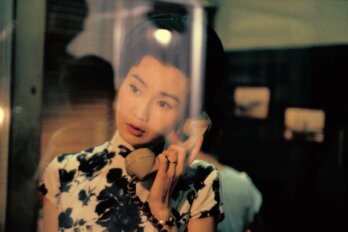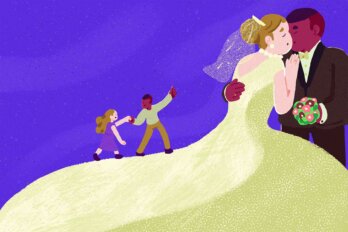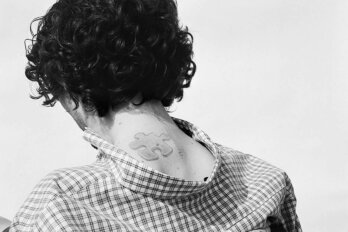The floor by the fireplace was covered with white-and-gold glitter. It was Eid in December and I was eight years-old. My mother had worked tirelessly that day, making dozens of little cut-outs, employing my sister and me as Muslim elves to her brown auntie Santa. We spent hours decorating the tiny paper mosques and crescent moons, making them shimmer. From there, we hung the DIY masterpieces from every branch of our plastic evergreen. Gold bangles adorned the entire tree; it dripped with golden beads and string. On the top, we placed a white crescent moon and star, shining for everyone to see. The Eid tree was a thing of beauty—and, perhaps, blasphemy.
This was more than fifteen years ago, when Ramadan was in December. Every year, Ramadan moves. It’s based on the Islamic lunar calendar, which is different than the Gregorian calendar that many others follow, and it shifts back 11 days each year. Back then, Eid al-Fitr, which marks the end of the thirty-day fasting period of Ramadan, arrived at the perfect time for every Muslim immigrant kid, including me, who wanted to feel like they belonged in a world suddenly decorated with blinking Christmas lights and red-and-green decorations.
The Eid tree was my family’s own unique invention, and I’ve yet to meet anyone else who’s done it. In a way, that doesn’t surprise me. Hardline folks in our community may not appreciate its special magic the same way I do—after all, it’s a fusion of a Christian celebration with an Islamic one. But we saw it as a fun, decorative thing, our special little way of being festive. The blending of those two holidays lasted only a couple of years before we had to retire the tree. It might not be until 2034 that Ramadan and Eid al-Fitr are back in December.
My family immigrated to Canada from Dubai in 1996, settling down on a quiet street in Mississauga. Today, there are over one million Muslims in Canada, but we make up only 3.2 percent of the population in the country. Many of us have settled in the Greater Toronto Area, of which Mississauga is a part. Muslims make up about 7.7 percent of the population of the GTA. It makes sense that many of us have settled here: there are great schools, lots of thriving cities, and enough of an immigrant population to form little neighbourhoods to make things feel more like back home. I don’t remember it, but according to my parents, I had trouble adjusting. I was two, going on three, and didn’t understand that there were other continents, other people, other ways of living. I acted up, got scared of everything, decided to reject my potty training. My big sister became quiet and was teased about her accent.
When we moved here, I’d never seen snow—let alone Christmas lights. The decorations hypnotized me. Every home shone with reds and yellows, blues and greens. Shiny ornaments on towering trees glimmered through people’s windows and candy-cane decorations filled up their lawns. Kids talked a lot about Santa Claus, who I soon decided was a generous man that flew in from the Arctic on a bunch of reindeer to give you presents, just ’cause! When I asked my father whether I’d also get gifts from Santa, he told me that we were Muslim and then conjured up a ridiculous tale about Baba Eid—a character he invented—who was basically Santa, but on a camel, and would indeed bring me some presents.
But I didn’t want Baba Eid; I wanted Santa Claus. Santa Claus was what all the other kids were talking about. Santa Claus was on people’s lawns. He was on TV. He was everywhere. The holiday specials weren’t about Baba Eid, and they didn’t talk about the importance of fasting. They spoke of candy and glitter and reindeer. My longing for Christmas grew stronger with every holiday craft we made in school, with every Christmas carol we learned in music class. My parents saw my yearning and felt for me. Enter my mother’s brilliant solution: the Eid tree. It combined the aesthetic of Christmas with our own religious and cultural tradition. Put the Eid presents under the Eid tree. Simulate Christmas, while still being Muslim, through arts and crafts. During those years, I loved that Eid came to me wrapped in a Christmasy bow. While I was growing up, it helped me feel like I was a part of life in Canada.
After Ramadan moved into fall, and then summer, and the Eid tree was gone, I grew less and less interested. I was frustrated with fasting, annoyed at having to attend Friday school—picture Sunday school for Muslims—plus a plethora of other things. Still, for a while, a family friend’s Eid al-Fitr party kept me in the spirit of celebration. It was an annual, and beloved, tradition throughout much of my early childhood. Our family friend threw a big bash at her house, filled with kids running about in their new shalwar kameez, aunties bringing in plates of sweets, and even a singer, though not a very good one, belting out the current Bollywood hits.
By my late middle-school years, however, the party began to fade as the community’s observance became more rigid. Political and religious trends were changing—no doubt affected by a post-9/11 paradigm shift. For some of my family and friends, celebration was out and puritanism was in. The party was replaced with a gathering, and the singer was replaced with an imam reciting dull sermons into a crowd of sleepy, pious people.
Islam, particularly for Sunni Muslims from certain parts of the world—such as Pakistan and the Gulf Arab states—was changing. Saudi-sanctioned Wahhabism, a hardline fundamentalist brand of Islam, gained popularity. Wahhabism claims to bring Muslims back to the most pure, original ways of Islam. In actuality, it’s a far cry from any of the historical roots of the faith and is, instead, directly tied to Saudi Arabia’s territorial and political interests in the Middle East. Many Muslims around the world have not adopted Wahhabist views. Those who haven’t, like me, believe that it isn’t taking us back to our great roots but instead forging new, conservative ones.
My extended family members, who have always been more conservative than my parents, would likely disagree. As some family members began to lean toward stricter interpretations of our faith, so, too, did friends of my parents. Things that weren’t haram (sinful or forbidden) before were haram now. And even before I had the words to describe this socio-political phenomenon, I understood that it was making things boring. Eid was no longer fun in my cultural community. And while the Eid tree was once the perfect way to connect the two cultural traditions, in this new political climate, it had become a relic. It no longer offered a way to make me feel like I could fit in at school, among my friends, in Canada. So I returned to Christmas.
Celebrating both holidays was not easy—or readily accepted. Christmas was not considered “our” holiday. I was still Muslim. I still participated in Ramadan and celebrated Eid. I was not supposed to be celebrating Jesus’s birthday. I wasn’t supposed to be singing “Silent Night,” and that fateful night in Bethlehem just isn’t that important to us Muslims. My parents didn’t mind, but I knew members of my extended family wouldn’t be happy if they found out. Even today, the controversy lingers: a family friend’s five-year-old child recently asked me why I celebrate Christmas, emphasizing that she didn’t, because she’s Muslim. I told her, “Well, I’m Muslim too”—but I’m not sure she believed me.
I bought my first Santa hat in grade eight and wore it to school for the entire month of December. It was then that I discovered the red-and-white hat had power. People wished me Merry Christmas, they smiled at me, we sang carols together. Nobody was this nice when I was fasting or when I went to the designated classroom for my afternoon prayers. Nobody smiled this much when I declined gummi worms with gelatin in them or said no to pepperoni pizzas. Loving Christmas was a social tool. The cool white girls in class liked my hat. People shared candy canes with me. This is how you fit in, I remember thinking. You have to become one of them. And for a while, I felt like I was one of them—or, rather, that I could be both Muslim and popular. I could feel like I belonged.
Then I slipped up. My family and I were invited to a little get-together at the very same house where we used to attend the amazing Eid parties. We were told it would be a small gathering. All of us kids were asked to write something on one subject in Islam. As a total keener who loved researching things, I happily penned a report on the adhan, the Islamic call to prayer. But when we walked in, I quickly realized it wasn’t a little get-together at all. It was a massive gathering of all their family and friends, complete with sermons. And there I was, standing in the middle of this newly conservative religious group in my Santa hat. I didn’t anticipate the reaction and, clearly, neither did my parents, who had never objected to me wearing the hat. They understood my yearning to fit it: wearing the hat at this time of year seemed like a totally normal thing to do.
Thirteen-year-old me tried to shrug off the hard stares, looks of shock and disapproval worn on the faces of everyone from the little kids to the elderly aunties, but I couldn’t. I ended up running to my father, sitting at his feet, tearing the hat off my head, and crying. I was humiliated. And angry. If my parents were okay with it, why wasn’t everyone else? I remember the look of sadness in my father’s eyes. He didn’t say much, but I knew he was angry. After all, there I was at his feet, sobbing. The Santa hat’s power betrayed me. These grown adults betrayed me by caring so much about this stupid fluffy thing on my head. Faith, on all sides, had stabbed me in the back.
Christmas is peddled to you by everything. It’s commercial, packaged, covered in tinsel, and sold to you. It’s on the billboards along the highway and it plays on repeat in cheesy commercials. It’s seen in the perfectly selected rustic plaid and wood-themed displays at Indigo. It’s sung to you on the radio by Mariah Carey. It’s a sensory explosion expertly marketed by both greeting-card executives and religious leaders. It’s lit up and loud and happy.
For many of us, Christmas is not religious at all—or it only barely is. You don’t have to do anything to earn it. No fasting, no praying, nothing. For years, I was drunk off of the Christmas aesthetic, the traditions, its looseness and flexibility. To me, it had no rules. It was just for fun. As a Muslim, Christmas has always felt a bit like Jesus is the popular guy in school and Christmas is when he has a big birthday bash and guess what, we are all invited! Well, some of us are. Then there are others, such as me, attending the party in secret, donning new Christmas aliases just so we can join in on the fun.
Celebrating it has helped me relate to my peers, and when I was a child, it even helped me relate to adults, including my teachers. Every time I drive by a house covered in Christmas lights, I become three years old again, hypnotized and in love. Sometimes, when I think of Christmas and my still-lingering love for it, I feel like a Muslim with an identity crisis—secretly (until now) reminiscing about my beloved Eid tree, the one thing that made all these things I value seem like they weren’t contradictions. If the Eid tree was a way for me to fit into both worlds, it also feels like a faraway memory.
Maybe, one day, this will change. If my immediate Muslim community went back to celebration, lights, Bollywood tracks, and glitter, maybe I wouldn’t need Christmas so much. Just because I love Christmas, it doesn’t mean I don’t care about Eid. But I want it back the way it was before. I have often wondered whether Christmas is just a placeholder, a thing to fill the increasingly widening gap between progressive Islam and its conservative counterpart. These days, I often look at old pictures of the Eid tree with nostalgic sadness, secretly hoping Baba Eid will bring me a present this year. But without a taste of the thing I’m missing, there’s no real way of telling whether Christmas is just a stand-in for the Eid tree, and everything it represents—at least, not for another seventeen years.






